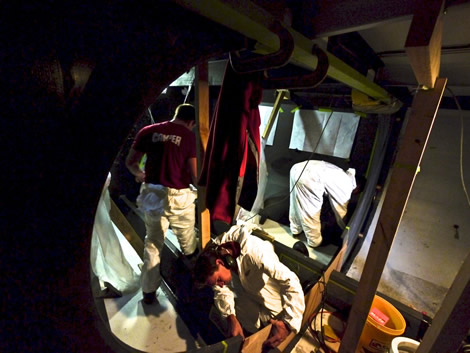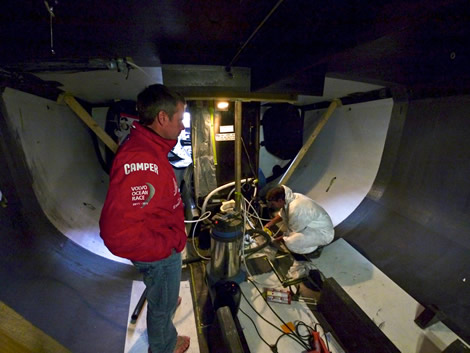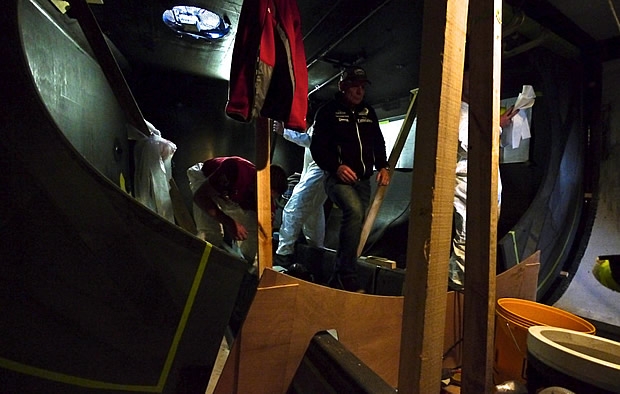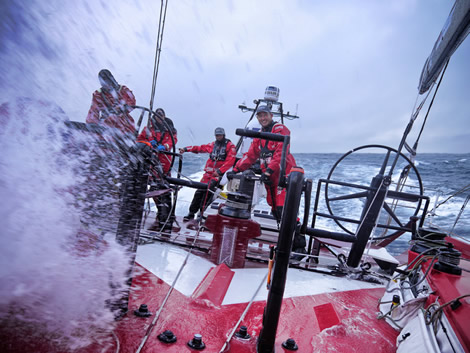Camper's ring frame collapse
Camper is due into Itajai imminently following her pitstop in Chile. At the 0955 UTC sched she had 242 miles to go to reach the Volvo Ocean Race’s Brazilian stopover.
The structural damage that occurred mid to the Team New Zealand-crewed boat as she was mid-Southern Ocean was the collapse of a ring frame in the mid-bow area. While this was nominally non-structural, according to Shore Manager Neil Cox, it did offer support for the longitudinals running the length of the boat that are.
Their massive diversion to Puerto Montt in Chile was for the exact same reasons as Abu Dhabi Ocean Racing, based on the remoteness of their location, as far away from land as it is possible to be on the planet. As Cox explains: “Although it never propagated into being at a critical point, to think that they were still 3000 miles from the Horn and the weather window that was there...weighing up the options would you gamble getting to Ushuaia and then making a repair there and being lucky enough to get around the corner? Or would you just get to Porto Montt? Everything just led to the safety of the boat and crew to go to Puerto Montt.”

Fortunately with the weight of an America’s Cup team behind them, complete with in-house designers, Cox says they could work with the Team New Zealand engineers (Giovanni Belgrano) who carried out FEA modelling to investigate what would happen to the hull without the ring frame, if the ring frame partially failed, or, if matters got worse, one or both of the longitudinals failed.
“We were pretty well versed in knowing what was happening. We even had the crew measure the deflection in the hull, knowing that it was going to cycle through a million times by the time the boat got to Puerto Montt, just knowing what was a safe number before there would be any core fatigue. So we were pretty comfortable with the limited amount of deflection that was there that we should be able to get the boat to Chile safely without there being any damage to the core itself in the hull.”
Cox says that, while in Puerto Montt, they ultrasounded the inner and outer skins and the core and there was no delamination or core failure, as occurred on Abu Dhabi Ocean Racing and Telefonica on this leg.
As to whether they could have made it to the Horn intact, that was a risk they weren’t prepared to take. “We nipped it in the bud. It doesn’t take much for this stuff to snowball. It was a massive juggling act with the safety of the boat and the crew being paramount, balanced with how do we stay in the leg and finish it? It wasn’t an option not to finish the leg. Then there is also an element of luck. The breeze could have swung 95-100deg, then they would have been bouncing off waves upwind. Fortunately that wasn’t the case.
“At the end of the day, we still believe we have a very good boat. It was a case of whether for a couple of extra points you risk the boat and it becomes a bigger deal. There are a couple of boats here that have got serious core shear failures and fortunately we are not one of them.”



According to Cox, this is the first structural issue the boat has had in 30,000 miles of racing. “The problem is that it may have caused a false sense of security that the boat was indestructible. No boat is indestructible – it is as simple as that.”
In Puerto Montt they replaced the ring frame – having had another made up at Cooksons in Auckland, where Camper was built. The ring frame was then shipped to Chile in two pieces which were then picked up from Santiago, 14 hours drive away from Puerto Montt.
“We had to bring everything,” says Cox of how they got set up in the remote Chilean port. “Puerto Montt is an amazing place, a stunning landscape. There is a human kindness there - everyone wanted to help. It was unfortunate, though - if we wanted to repair a steel trawler, no problem at all, but for what we wanted to do there was nothing available, so we had to be totally self-sufficent. Because both containers were in transit, we were lucky enough to get into the Team New Zealand base, and the guys leant us some tools and could get what we wanted materials-wise.” All of which was shipped.
The team with Cox in Puerto Montt worked flat out for 81 of the 84 hours Camper was in port. “I cannot praise these guys highly enough. They were just into it.”
The hardest part of the operation was the post-cure. They needed to get the temperature inside the hull up to 60°C for at least eight hours, only this was an issue, particularly lower down in the hull, due to it sitting in 10°C water. “Fortunately as the heat cycled through, we could get the temperatures pretty well balanced. At the end of the day we were in Porto Mont with a borrowed gas heater and we were literally in there working during that whole post cure in a 60°C temperate. I was circulating and venting air by opening watertight bulkheads and deck hatches to try and get the heat evenly distributed through the boat - it must have been quite comedic to watch! But at the same time you have to do what you have got to do.”
Abu Dhabi Ocean Racing was parked 250m down the river at the yacht club, but the agendas for the two campaign were different - Ian Walker's team was preparing for its boat to be shipped, while the Camper shoreteam was up to its elbows in repairwork.
The criticism that the Volvo Ocean Race has come under for the breakages and just one boat getting to Itajai without significant structural issues is misplaced Cox feels. “I still think these boats are phenomenal. They seem to get blamed for a lot for stuff they are not entitled to be blamed for. At the end of the day I don’t think anyone jumps on Rubens Barrichello if he doesn’t finish a Grand Prix. Unfortunately we are little more isolated. We are stuck in the middle of an ocean trying to get a boat back to port.
“We work to a rule that we have got and as a competitive team we have tried to optimise that rule as best we can. There are some pretty smart engineers who work on this stuff. You don’t show up to this race to measure in with a boat that is a ton heavier than everyone else’s.”
He also counters the “why don’t you throw another 500kg of structure in the boat and finish the race?” argument: If you do this, then your VO70 will simply not measure. “We have a maximum draft of 4.5m, and we have all been floated to that rule. If you started adding weight you won’t have your measurement certificate any more because your draft will be too deep, because every 60kg sinks the boat 1mm. Then, all of a sudden, all of your feedboard and mast datum screws don’t fit and you have an illegal boat.”
Whether it is relevant to the breakages or not, Cox (who has done the race three times before, with SEB and as shore manager for ABN AMRO One and Puma) says the schedule this time is incredibly tough, especially for the sailors. “They can barely scratch themselves when they get off the boat. These guys are gaunt. The amount of time off they had off in Auckland was basically two days. Our guys at the very best are going to get two days off here. Then the stuff you have to do in port - your obligations, the pro-ams and in-ports - and then you’re off on the next leg, let alone your own responsibility on the boat, food and sails, rig work, etc. We are doing all we can to offload that stuff from them... So there is not a lot of time to recover. The schedule itself is incredibly demanding, even if there weren’t breakages.”
And in points terms at least the race is only half over. “It is anyone’s race right now. If by the time we get to Miami all the top three or four boats are all within 10-15 points of one another, that would be great for the race. Everyone will be puckered up until the finish. I know we have got so much more potential to tap into, so hopefully we could have a close finish. If you look at the sailing team right now, they are a gutsy bunch of guys, they are not going to quit. It is a different race course - it is open season and if people put their head now, it would be foolish. The opportunities are massive right now. At the end of the day this is hopefully the worst part of the race behind us. There is so much more to unfold. It is almost like two races.”
See our full guided tour to the Camper VO70 here












Latest Comments
Add a comment - Members log in